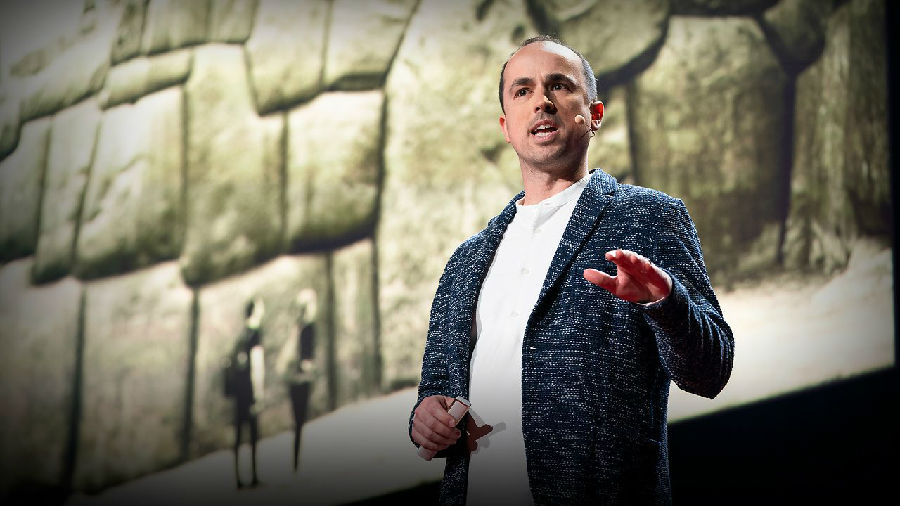(单词翻译:单击)
Do you think the things we build today will be considered wonders in the future?
当今时代的建筑,在未来会是奇迹吗?
Think of Stonehenge, the Pyramids, Machu Picchu and Easter Island.
就像巨石阵、金字塔、马丘比丘和复活节岛一样。
Now, they're all pretty different from what we're doing today,
这些建筑和现今的建筑有天壤之别,
with those massive stones, assembled in complex but seemingly illogical ways,
它们由巨大的石头,以复杂、似乎没有逻辑的形式堆叠而成,
and all traces of their construction erased, shrouding them in mystery.
而它们所有的建造痕迹都被抹去了,让它们成为了人类历史的不解之谜。
It seems like people could not have possibly built these things, because people didn't.
很难想象人类能够建造这些奇迹,因为它们不是人类建造的。
They were carefully crafted by a primordial race of giants known as Cyclops.
它们是一群原始巨人精心打磨成的,也就是独眼巨人。
And I've been collaborating with these monsters to learn their secrets for moving those massive stones.
我最近和这群巨人合作,来揭示它们移动巨石的秘密。
And as it turns out, Cyclops aren't even that strong.
结果我发现,独眼巨人没那么强壮。
They're just really smart about getting material to work for them.
他们只是非常聪明,善于操控物体。
Now, the videos you see behind me of large, stone-like, wobbly creatures are the results of this collaboration.
我身后的视频中,大家看到的巨大、石头样的摇晃的物体,就是这次合作的成果。
OK, so Cyclops might be a mythical creature, but those wonders are still real.
好吧,独眼巨人只是个传说,但这些史前奇迹是真实存在的。
People made them. But they also made the myths that surround them,
它们是由人类建造的。它们也引发了许多神话,
and when it comes to wonders, there's this thick connective tissue between mythology and reality.
而在神话和现实之间,则有着深厚的联系。
Take Easter Island, for example.
比如复活节岛。
When the Dutch explorers first encountered the island,
荷兰探险家首次发现这个岛的时候,
they asked the people of Rapa Nui how their ancestors could have possibly moved those massive statues.
问当地的拉帕努伊居民,他们的祖先是怎么挪动这些巨石的。

And the Rapa Nui said, "Our ancestors didn't move the statues, because the statues walked themselves."
拉帕努伊人说:“我们的祖先没有挪这些雕像,因为雕像自己会走路。”
For centuries, this was dismissed, but actually it's true.
几个世纪以来,该说法一直被人们忽视,但这却是真相。
The statues, known as moai, were transported standing, pivoting from side to side. OK?
这些雕像,也被称为摩艾巨石,是直立着,不断旋转着运输的。能想象吧?
As spectacular as the moai are for visitors today,
今天大家看到这些巨石觉得很壮观,
you have to imagine being there then, with colossal moai marching around the island.
那想象一下当年的景象,巨大雕像在岛上行走的样子岂不更加壮观。
Because the real memorial was not the objects themselves, it was the cultural ritual of bringing a stone to life.
因为它们的真正意义,不是这些物体本身,而是赋予石头“生命”的文化仪式。
So as an architect, I've been chasing that dream.
作为一个建筑师,这就是我的梦想。
How can we shift our idea of construction to accommodate that mythical side?
我们如何将思维从打造建筑转变为创造神话?
So what I've been doing is challenging myself
所以我一直在挑战自我,
with putting on a series of performances of the ancient but pretty straightforward task of just moving and standing big heavy objects,
进行一系列古老但非常直接的、移动站立的、巨大笨重物体的展示,
like this 16-foot-tall megalith designed to walk across land and stand vertically;
比如这块设计为可在地面行走、并竖直站立的16英尺高巨石;
or this 4,000-pound behemoth that springs itself to life to dance onstage.
再比如这个可以一跃而起、在台上起舞的4000磅的庞然大物。
And what I've found is that by thinking of architecture not as an end product
通过这些,我发现,如果不把建筑看作最终成品,
but as a performance from conception to completion,
而是看作一场表演,从概念一直到成品,
we end up rediscovering some really smart ways to build things today.
我们就可以重新发现非常精妙的建造方式。
You know, so much of the discussion surrounding our future focuses on technology, efficiency and speed.
太多关于未来建筑的讨论,都是关于科技、效率和速度。
But if I've learned anything from Cyclops, it's that wonders can be smart, spectacular and sustainable
但是独眼巨人教会了我一件事:奇迹之所以精妙、壮观,而且经久不衰,
because of their mass and their mystery.
正是因为它们的巨大和神秘。
And while people still want to know how those ancient wonders were built,
尽管人们还在猜测,这些古老奇迹是怎么建造的,
I've been asking Cyclops how to create the mystery that compels people to ask that very question.
我却在向独眼巨人提问:如何建造引发这些猜测的奇迹?
Because in an era where we design buildings to last 30, maybe 60 years,
因为在这个建筑物只有30年、也许60年寿命的时代,
I would love to learn how to create something that could entertain for an eternity. Thank you.
学习创造亘古永恒的奇迹,该是多么美妙啊。谢谢。


